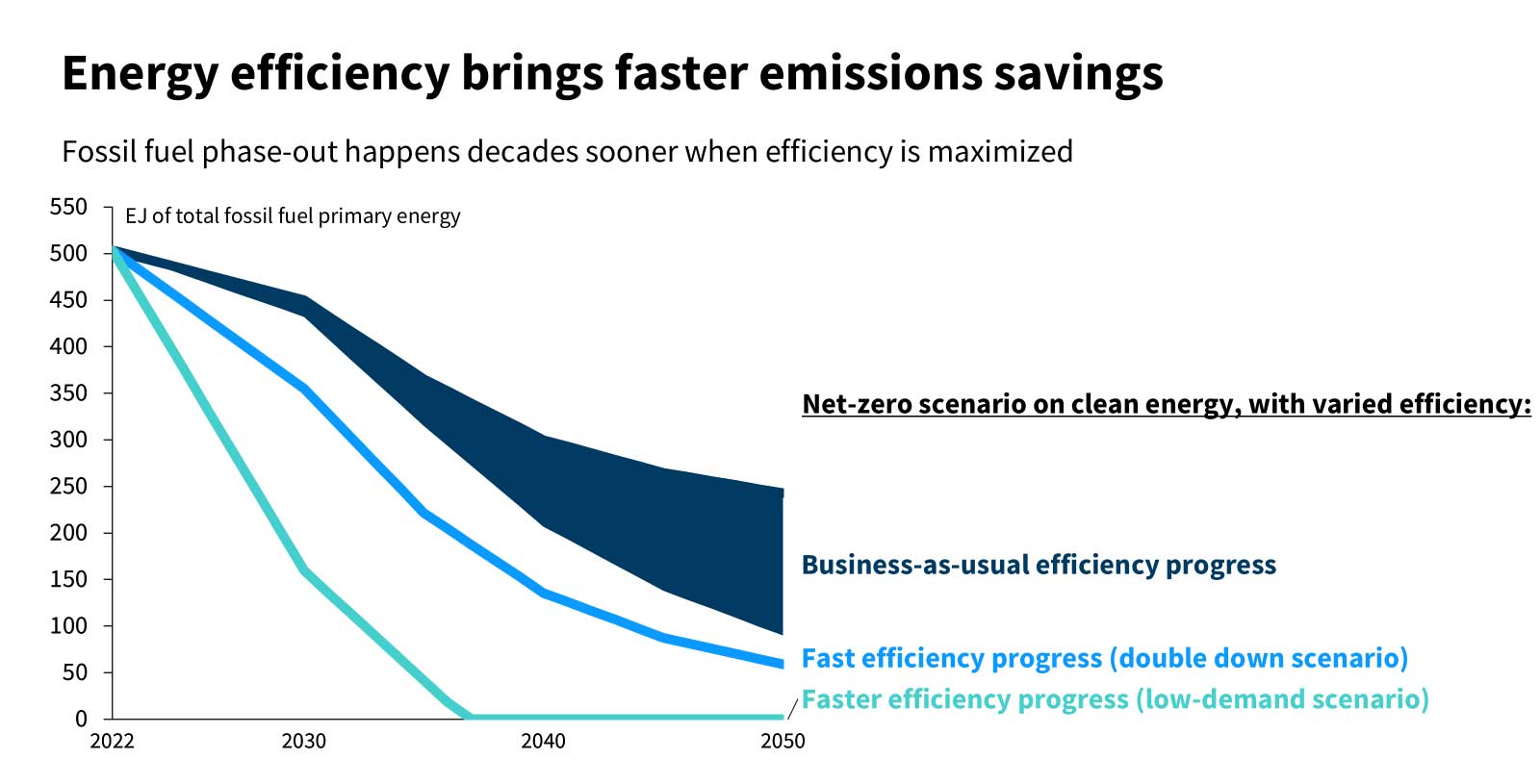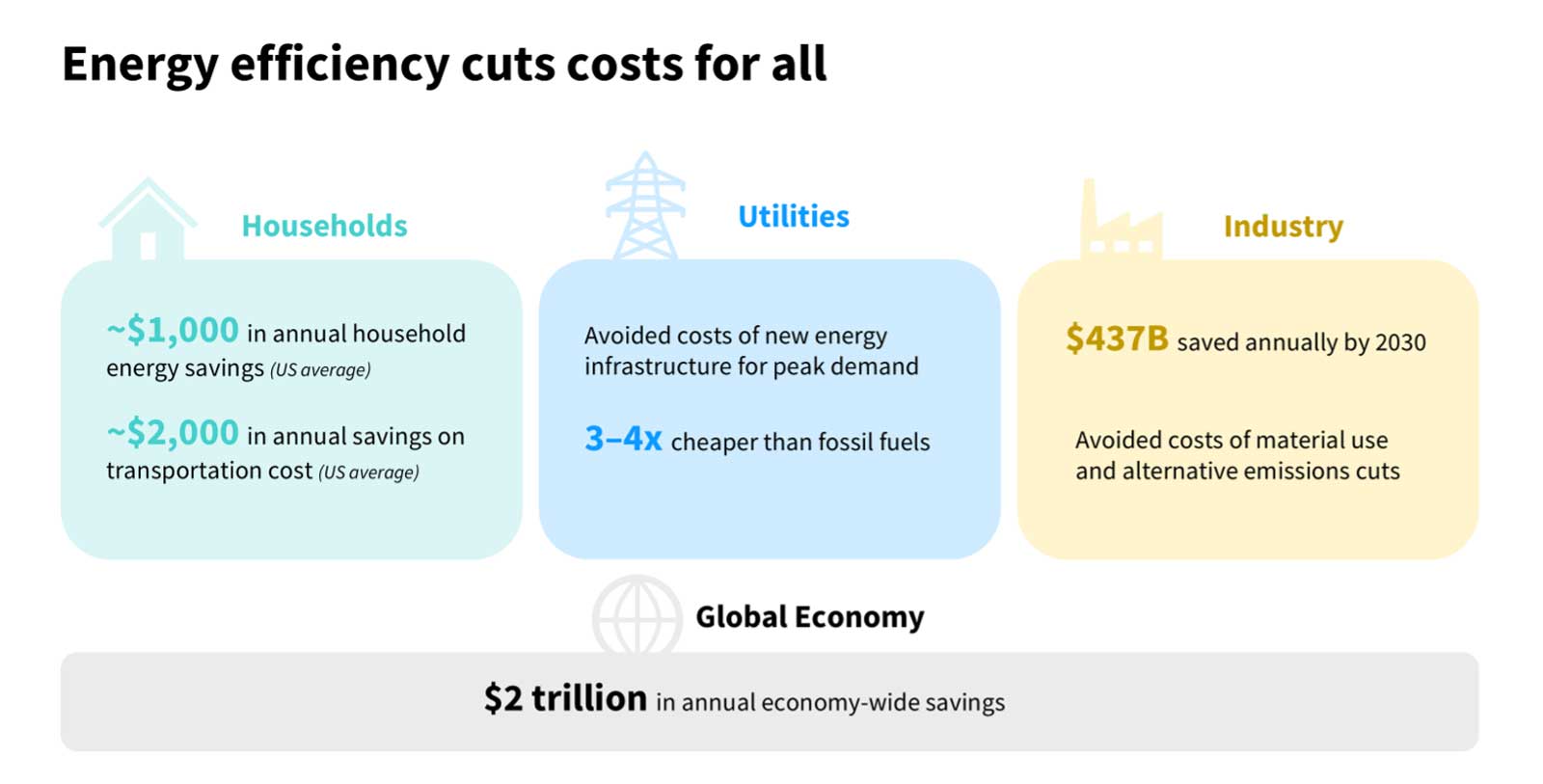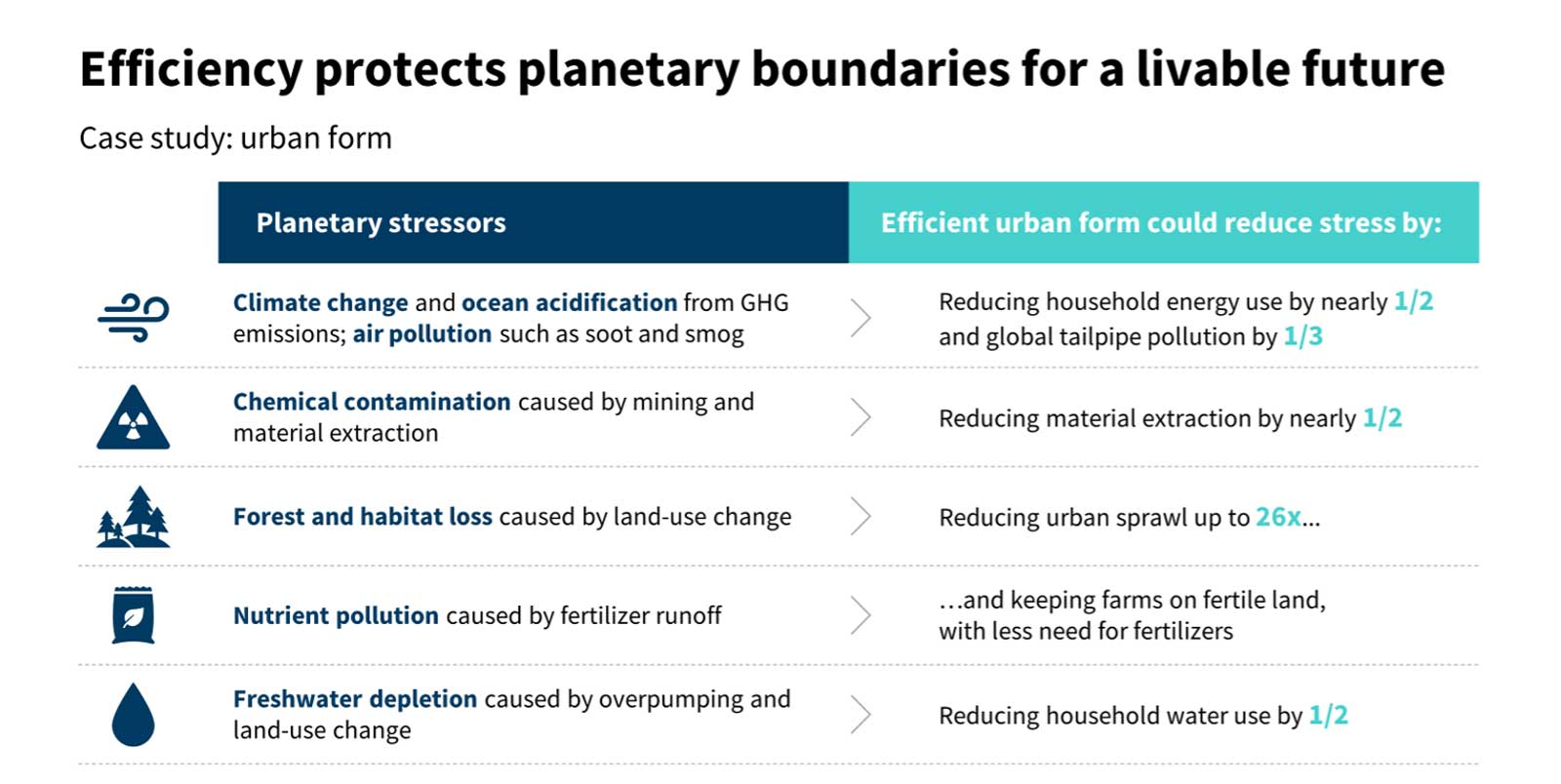
Why Efficiency Matters: Unlocking Benefits Beyond Climate for All
Energy efficiency is critical to make climate action faster, cheaper, more equitable, and more widely beneficial for the planet.
Today’s energy system is inefficient, wasting two-thirds of global energy production. That means about $4.5 trillion in economic losses every year as well as major health, climate, and other environmental damage that deepen inequities. How do we reduce these impacts?
A large part of the solution will be replacing fossil fuel technologies with rapidly scaling renewable energy and electrification solutions, which are often two to four times more efficient. However, delivering fully on the promise of energy efficiency also means creating more efficient products, buildings and factories, and broader systems.
A whole systems approach to energy efficiency, coupled with a rapid transition to renewable energy, puts our most important climate goals within reach alongside a wide range of benefits. In this article, we demonstrate the key role that efficiency can and should play in making the energy transition faster, more affordable, and more equitable, while doing even more for the Earth than just reducing emissions.
Faster emissions reductions
By shrinking the total amount of energy that we need, efficiency can enable a carbon-free energy system a decade or more earlier than would be possible otherwise. This saves precious time and resources by reducing the fossil fuel demand that renewables will replace.
Maximizing energy efficiency progress in a low energy demand scenario would enable fossil fuel phase-out before 2040. But compared to a net-zero scenario that meets international efforts to “double down” on efficiency progress, failing to double down could make midcentury fossil fuel demand two to four times higher.
Furthermore, while renewables deployment is rising exponentially, reducing demand can deliver emissions reductions faster still. Retiring fossil fuel assets and equipment (like a power plant or a gas- or diesel-powered vehicle) sooner than their “natural” end-of-life can be challenging. But taking a car off the road or reducing a kilowatt-hour of electricity consumption can deliver impact immediately — regardless of the vehicle type or grid mix.
Rapid efficiency actions in emerging market countries, where much will be built in the next few decades, will also bring savings that are abundant and long-lived. In India, where the total floor area may double before 2040, efficient design and construction of buildings could save 25 percent of projected building energy demand by 2050, while reducing emissions-intensive materials by 45 percent.

Source: Grubler et al. (2018) for the low energy demand scenario, IEA World Energy Outlook (2023) for all other scenarios.
Making the energy transition more affordable
Energy efficiency is already saving many billions of dollars for the global economy. In 2022, energy efficiency measures implemented in dozens of countries saved approximately 15 percent of their total energy bill in the same year. Looking ahead, global energy efficiency measures by 2030 could reduce energy costs by 20–25 percent for up to US$2 trillion in annual savings.
How? First, by reducing the energy bill for consumers. For example, simple measures such as sealing drafts and air leaks, improving insulation, and updating HVAC systems can save 10–20 percent of the average American’s annual energy bill. Deep retrofits can deepen the benefits, reducing home energy use by 50–80 percent. Transportation is similar: a combination of strategies supporting electrification, compact and mixed-use urban development, and sustainable mobility (including better public transit service, walking, cycling and electric micro-mobility) could save each urban American an average of $2,000 every year.
Consumer cost savings extend to utilities. Energy efficiency is typically the lowest-cost resource for utilities, being 3–4 times cheaper than fossil fuels and cheaper than wind and solar in many cases. Efficiency brings further benefits by avoiding the costs of building new power lines, substations, and transformers that would be needed to meet higher peak demand — as well as the costly risks from generation capacity, regulatory compliance, and more. Load flexibility, sometimes dubbed “Energy Efficiency 2.0,” delivers similar benefits to reduce system costs.
Commercial and industrial players can also save energy to cut costs. Efficiency can save industry $437 billion annually by 2030. This figure could be even greater if we also achieve cost savings from reduced material use and increased circularity, which can nearly halve steel and cement use and avoid the costs of alternative emissions control measures in high-cost harder to abate sectors.

Making the energy transition more equitable
By decreasing energy cost burdens associated with household energy use and transportation, energy efficiency brings disproportionate benefits for low-income households. Energy cost burdens, measured as the percent of gross household income spent on energy, are highly unequal. In developed economies, the poorest 10 percent of households typically have more than quadruple the energy burden than the richest 10 percent. Lower energy use also means reduced exposure to energy price shocks, which disproportionately affect low-income households and can cause other issues such as food insecurity.
Beyond this, home efficiency upgrades also boost household resilience to severe weather events by extending the time that buildings maintain safe indoor temperatures without power. That time of safety could grow from eight hours to six days, according to RMI research of an uninsulated pre-1950 home versus a home meeting the Passive House standard. In informal settlements, advanced cool roof materials can reduce indoor air temperatures by 5°C to 10°C (9oF to 18oF), which could save lives in a heat wave. These benefits are greatest for low-income households because they are at highest risk of exposure to extreme heat.
Energy efficiency also increases local jobs and access to jobs. Efficiency can create nearly triple the jobs per investment dollar compared to fossil fuels, and double the rate for solar power. A majority of efficiency jobs are in construction, manufacturing, wholesale, distribution, or transport. These are difficult to automate, outsource, or offshore, so they stay in local communities.
Efficient public transit will also boost access to more job opportunities, especially for those who cannot drive or afford a car. In Medellín, Colombia, for example, a new cable car system connected the city’s lowest income neighborhoods to the central metro system, doubling access to employment opportunities for riders. This brought additional benefits such as reduced crime rates and new business investments.
Finally, efficiency reduces health inequities in many ways. It is well-documented that lower-income Black, Indigenous, and People of Color communities are disproportionately exposed to the toxic air and water pollution from fossil fuels. By enabling faster fossil fuel phase-out, energy efficiency can save millions of annual air pollution deaths. System-wide efficiency can save even more through healthier homes, urban nature, less tire pollution, fewer car crashes, and more active mobility — like in New York City, where bike lanes gave residents an extra year of healthy life at far lower cost than most health interventions.

Maximizing protection of the Earth system
Efficiency’s compounding benefits extend from people to planet. Renewables and electrification help reduce the damage caused to our air, water, and ecosystems from fossil fuel extraction and processing. But by reducing the need for all forms of resource extraction, efficiency is an even more powerful force for preserving or restoring nature.
These effects are embodied in the planetary boundaries framework, which identifies nine processes that regulate the stability of the Earth system. According to a comprehensive US study, even a shift to 70 percent clean energy by 2030 would transgress five of those boundaries. No purely “supply-side” scenario protects all boundaries — but energy efficiency can help us go further.
For example, let’s consider the benefits of efficient cities. With urban sprawl linked to one-third of greenhouse gas emissions, how can efficiency help?
First, efficient cities can reduce car usage and decrease global tailpipe pollution by 30 percent or more. Reducing car dependence also reduces global mining, manufacturing, and shipping from the whole vehicle system, from battery minerals and untested chemicals to the fossil-fueled asphalt of roads themselves. Avoiding that extraction avoids the harm to forests, freshwater, and biodiversity.
Meanwhile, compact buildings in efficient cities — for example, multi-family homes instead of single-family homes — can reduce household energy use by 27–47 percent, materials use by 30–45 percent, and water use by half.
Finally, reducing sprawl means preserving land. With development, every acre of direct forest loss brings 5–10 acres of indirect loss through farmland displacement. Keeping farmland in the most productive areas means less use of fertilizer and other inputs (reducing nutrient pollution), and more protection for the natural ecosystems that absorb half our carbon pollution.
Other efficiency measures can compound even further, from material circularity to efficient food systems. While often less visible, these compounding benefits are nearly limitless.

Sources: IPCC AR6 WGIII Chapter 5 (2023), LSE Cities (2014). Berrill et al. (2021), Kiefer and Krentz (2018), Berrill and Hertwich (2021), Stockholm Resilience Centre, RMI Land Use Reform (2023)
Seizing the opportunity
Efficiency makes the energy transition faster, cheaper, more equitable, and more widely beneficial for the planet. Yet, despite its far-reaching benefits, energy efficiency continues to receive less attention and less investment than clean energy supply. Renewables outpace efficiency by a factor of two to five across national pledges, corporate commitments, and public search history.
Concerted action is still needed to align and strengthen the actions of governments, businesses, and households to unlock the vast efficiency resource. Government policies that prioritize energy efficiency will be crucial to overcome market failures such as split incentives between renters and owners; to improve transparency, affordability, and access to efficient products for consumers; and to enable systemic efficiency measures such as compact urban form. Simultaneously, corporations with a dedicated focus on energy efficiency are helping to drive progress by building on key policy measures and solving barriers through collaboration.
Harvesting the rich benefits of increased energy efficiency is the work of many diverse actors, from consumers and small businesses to governments and large corporations. This people-centric feature is an asset, not a disadvantage, as the abundant benefits of increased efficiency are indeed close at hand to those driving this essential part of the energy transition.
